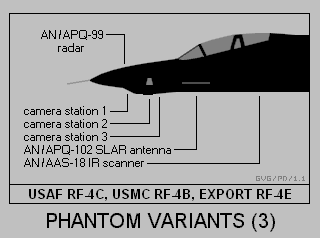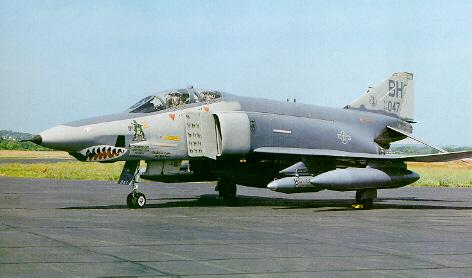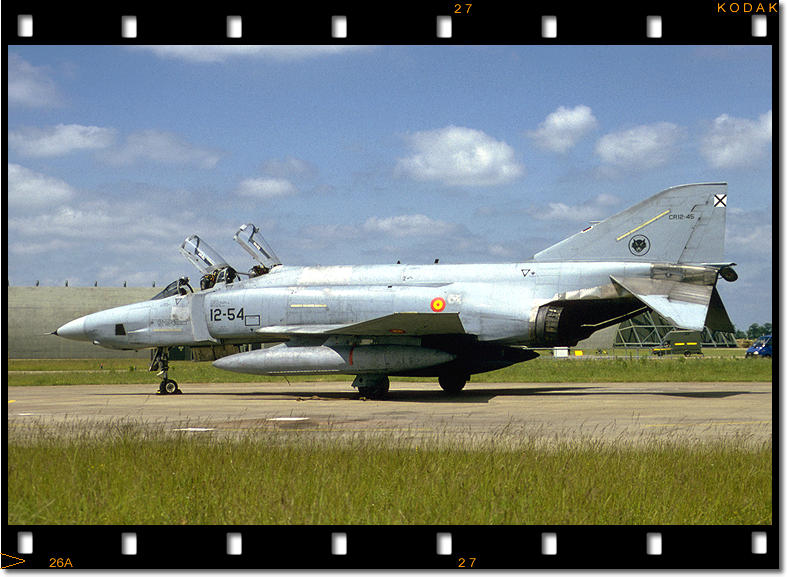

Article fait par :Claude Balmefrezol
Mis en ligne le

Le RF-4C Phantom II
English Version
 |
Introduction
Le F3H-J qui est une version similaire au Models 98 C et D.
Herman Barkley decide que le F3H-G Model 98B avec 2 réacteurs J65s offre le meilleur potentiel et decide de ne se consacrer qu’à cette version en abandonnant les autres versions
Une maquette du the Model 98B (F3H-G) grandeur nature est alors construite
Le 19 Septembre 1953, McDonnell propose le Model 98B au BuAer ( Navy's Bureau of Aeronautics) L’US Navy n’a pas pour l’heure besoin de nouveaux avions car les Grumman XF9F-9 Tiger et Vought XF8U-1 Crusader ont été commandés en Avril and Juin 1953
McDonnell essaye de convaincre la Navy de financer le développement de ce nouvel avion La Navy encourage McDonnell a revoir sa copie
McDonnell en Août 1954 propose une nouvelle version de son F3H-G/H ; Cette étude entraîne en Octobre 1954 une lettre d’intention pour la construction de 2 prototypes et un avion statique.
Le projet est baptisé AH-1 ce qui prouve que cet avion est destiné aux missions d’attaque au sol . De plus il doit avoir au moins 11points d’ancrage d’armes et 4 canons de 20-mm .
Mais tout change rapidement et en décembre 1954, la Navy transforme son projet de chasseur multi rôle en intercepteur tous temps. McDonnell doit “poncer” son avion en enlevant tous les points d attache sauf celui central pour le bidon auxiliaire de 2271 litres (600 Us gallon) et les canons . la place des points d’ancrage pour 4 Missiles Raytheon Sparrow . Ces missiles sont asservi à un radar Raytheon APQ-50 radar (déjà en place sur le F3H-2 Demon ) De plus le futur avion doit être biplace radar ).L’avion aura un armement entièrement basé sur les missiles Le 15 Avril 1955, le choix se porte sur le réacteur J79 et le 23 Juin1955, le nouvel avion reçoit la désignation deYF4H-1, ce qui devient chez McDonnell 98Q.
Le contrat pour 18 avions fut signé le 24 juin et la maquette grandeur nature fut présentée et examinée entre le 17et le 29 novembre 1955 Dans le même temps la Navy donne son autorisation à Vought pour la construction d’un avion utilisant le même réacteur mais en version monomoteur sous le nom de F8U-3 Crusader III .
Le chasseur de McDonnell rencontre de graves problèmes notamment de stabilité à des vitesses inférieures à Mach 2 D’importantes modifications s’imposent .
Le 19 Décembre 1956, la Navy commande 11 nouveaux F4H-1s (Bu Numéros 145307/145317).
Les premiers YF4H-1 sont équipés de réacteurs General Electric J79-GE-8 au lieu de J79-GE-3A .
Le YF4H-1 décolle pour la première fois le 27 Mai 1958, de l’aéroport Lambert St. Louis Municipal Airport avec aux commandes le pilote d’essai de la firme McDonnell Robert C. Little Le deuxième vol a lieu le 29 Mai 1958 Entre le 31 Mai et le 2 Juin L’appareil atteint les vitesses de Mach 1.30 et Mach 1.68.
La compétition entre le YF4H-1 et le F8U-3 se déroule en décembre 1958 avec comme vainqueur le F4H-1 .
le 17décembre 1958, McDonnell reçoit une commande totale de 45 avions.Le 3 juillet 1959, le F4H-1 est baptisé Phantom II. Mais le Nombre II fut souvent omis
LeYF4H-1 bat de nombreux records
Le 6 Décembre 1959 30 Kms d’altitude sont atteints et le 22 Décembre 1961 c’est le record de vitesse qui est à son tour battu à Mach 2.5.
Les performances impressionnantes du chasseur de la Navy attirent l’attention du Secrétaire d’état à la Défense Robert Mc Namara, qui cherche à réduire les coûts de développement des avions en faisant fabriquer des avions communs aux deux armes
Aussi en 1961 il décide de soumettre le F4H-1 Phantom II à des test d’évaluation.C’est l’Operation Highspeed qui voit une compétition entre le F4H-1 et le F-106A
Le F4H-1 sort vainqueur des tests et de plus il est plus facile à mettre en ouvre que le F-105 Thunderchief, et même dans le rôle de reconnaissance il bat le RF-101A/C
Aussi en Janvier1962, JFK décide de faire adopter le F4H-1 par l » Us Air Force sous le nom de F-110. Le F-110A sera la version chasseur tactique alors que le RF-110A sera la version reconnaissance Le nom du ce avion sera le Spectre .
 |
|
Spectre F110 A
|
Unités ayant utilisés le F-4C (source internet ) 8th Tactical Fighter Wing
12th Tactical Fighter Wing
15th Tactical Fighter Wing
18th Tactical Fighter Wing (44th TFS, 67th TFS), Kadena AB, Okinawa with detachments to Korat RTAFB.
32nd Tactical Fighter Wing
35th Tactical Fighter Wing
52nd Tactical Fighter Wing
57th Fighter Weapons Wing
57th Fighter Interceptor Squadron
58th Tactical Fighter Training Wing
81st Tactical Fighter Wing
86th Tactical Fighter Wing
347th Tactical Fighter Wing
355th Tactical Fighter Wing
366th Tactical Fighter Wing
401st Tactical Fighter Wing
405th Fighter Wing
475th Tactical Fighter Wing
479th Tactical Fighter Wing
3247th Test Squadron
4453rd Combat Crew Training Wing
4525th Fighter Weapons Wing
4531st Tactical Fighter Wing
6512th Test Squadron
Air national Guard:
110th TFS, 131st TFW, Missouri ANG
111th FIS, 147th FIG, Texas ANG
113th TFS, 181st TFG, Indiana ANG
114th TFTS, 142nd FIG, Oregon ANG
122nd TFS, 159th TFG, Louisiana ANG
123rd FIS, 142nd FIG, Oregon ANG
136th FIS, 107th FIG, New York ANG
163rd TFS, 122nd TFW, Indiana ANG
170th TFS, 183rd TFG, Illinois ANG
171st FIS, 191st FIG, Michigan ANG
182nd TFS, 149th TFG, Texas ANG
184th TFS, 188th TFG, Arkansas ANG
196th TFS, 163rd TFG, California ANG
199th TFS, 154th CB, Hawaii ANG
Le modèle F4 C ne fut exporté que sur l’Espagne en 1971 (17ex machines de l’Us Air Force).
Le RF-4C (Model 98DF)
 |
C ‘est la version non armé (à l’origine du F-4C. )
Les équipements du F4 c (radar et armes ) ont été remplacés par des équipements spéciaux pour la reconnaissance . On reconnaît un RF-4C à son long nez qui emporte divers équipements propres à sa mission .
Les études sur cet avion ont debute avec le projet Model 98 début 1950
La première version fut le 98F présentée le 25 août 1953.
Deux autres Model 98AX (Septembre 1958) et 98DF (Janvier 1961) ont été développés plus une version Model 98DH (RF-4B) pour l’USMC.
La maquette est présentée en Octobre 1962 suivit du premier vol le 9 août 1963.
The RF-4C a 3 “centrales” de camera dans son nez.
KS-87 camera. KA-56 (basse altitude ) et KS-87 camera pour les prises de vues obliques
Le RF-4C possède les équipements pour la photographie de nuit.Le radar du F4C( AN/APQ-72 ) est remplacé par un radar plus petit de Texas Instruments AN/APQ-99
Il possède un radar de suivi du terrain Goodyear AN/APQ-102 qui sera ensuite remplacé par un AN/APD-10
Certains F-4Cs recevront un nez plus aérodynamique
Les capacités de Contre-mesures électroniques seront au fur et à mesure améliorées &vec en final le Litton AN/ALQ-125 TEREC (Tactical Electronic Reconnaissance)
Au début le RF-4C n ‘etait pas armé par la suite il pourra être armé avec des Sparrow et même pourra emporté de façon exceptionnelle le Mk 82
Les appareils bases en Europe pourront même largues des bombes AJB-7
Le premier RF-4Cs sera produit en septembre 1964 .Il sera affecté au 33rd TRTS, Shaw AFB South Carolina.
La première unité opérationnelle sur RF-4C fut le 16th Tactical Reconnaissance Squadron of the 363rd TRW at Shaw AFB, en aout1965..
Il fut déployé en Octobre 1965 au Vietnam au 460th TRW, the 16th Tactical Reconnaissance Squadron à Tan Sun Nhut.
Ensuite il volera et combattra en 1991 lors de la Première Guerre du Golfe
12 RF-4Cs seront transférés à l ‘Espagne et 2 à Israël en 1970-71 12e ex-USAF RF-4C à la Corée en 1989.
 |
 |
| RF4 C USA | RF4 C Espagne |
62-12100/12101 McDonnell RF-110A Spectre
rebaptisé RF-4C-14-MC
Unités de l ‘US Air Forces ayant voles sur RF-4C:(Source Internet )
18th Tactical Fighter Wing, 15th TRS.
26th Tactical Reconnaissance Wing
66th Tactical Reconnaissance Wing
75th Tactical Reconnaissance Wing
363rd Tactical Reconnaissance Wing
432nd Tactical Reconnaissance Wing
460th Tactical Reconnaissance Wing
106th TRS, 117th TRW, Alabama ANG
153rd TRS, 186th TRG, Mississippi ANG
160th TRS, 187th TRG, Alabama ANG
165th TRS, 123rd TRW, Kentucky ANG
173rd TRS, 155th TRG, Nebraska ANG
179th TRS, 148th TRG, Minnesota ANG
189th TRTF, 124th TRG, Idaho ANG
190th TRS, 124th TRG, Idaho ANG
192nd TRS, 152nd TRG, Nevada ANG
196th TRS, 163rd TRG, California ANG
.jpg) |
.jpg) |
.jpg) |
.jpg) |
| Corée du Sud | Espagne | Israël | USA |
Maximum 26 T
Dimensions
Longueur 18.95 m
Envergure 11.73 m
Hauteur 5.5 m
Surfaire alaire 530 m2
Motorisation 2 réacteurs GE J79-GE-15 à post combustion
Vitesse:
Maximum Mach 2.2 à 15000 mètres
Mach 1.09 niveau mer
Vitesse Croisière . Cruising speed 950km/h
Autonomie 1351 kms sans ravitaillement avec bidons externes
Armement normalement Aucun
Voir texte
Equipement Voir texte
Merci à Jean Marie Brams pour les Photos de ce RF4 C du MRA de Bruxelles
The RF-4C Phantom II
 |
Introduction
The Phantom is a living proof that with enough power, even a brick can fly The McDonnell Phantom was one of the most successful postwar fighters. It was one of the most prolific jet fighter to be built, with the Sabre and the F16 . Total US production in 20 years (1959 1979) was 5057, with another 138 being built under license in Japan. During the Vietnam War, 72 Phantoms were coming off the production line every month.
Although initially designed as an interceptor and later used primarily in the air-to-ground strike role, and also in the USAF, Navy, He fighted in evrery part of the Wordl . First in Veitnam ,war ahieved with 277 air-to-air combat victories in Vietnam. In Israel with 116 victories .
He Has carrierd the rosettes of the United States Air Force, the United States Navy, and the United States Marine Corps. Australia, Egypt, Federal Republic of Germany, Greece, Iran, Israel, Japan, Republic of Korea, Spain, and Turkey. United Kingdom ( Royal Navy and the Royal Air Force ). He was the first jet to be able to identify, intercept and destroy any target that came into range of its radar without having to rely on ground control. The conception of the F-4 Phantom began in August of 1953 when McDonnell design a team headed by Herman Barkley. Initially, the goal of the team was to extend the production life of the F3H Demon boosting its performance . It wild be the F3H-C or "Super Demon". The F3H-C was to be powered by a single Wright J67 (turbojet license-built version of the British-built Bristol Olympus turbojet engine ) was to be capable of reaching Mach 1.69 at high altitude. The firm work on others projects .
The F3H-E (also known as Model 98A by the company)
The F3H-G (Model 98B ) was to be powered by a pair of Wright J65-W-2 or W-4. The twin-engined configuration was attractive to many in the Navy, because of the increased amount of safety
The F3H-G aircraft was to be equipped with an Aero 11B fire control system and an AN/APQ-150 radar. Armament was to consist of four 20-mm cannon, but provision for a retractable pack carrying 56 two-inch FFAR rockets was also proposed. A heavy load of bombs and fuel tanks could be carried on up to nine external stores stations (four under each wing and one underneath the fuselage)
The F3H-H was the same of the F3H-G, but with 2 General Electric J79 turbojets.
The F3H-J was similar to Models 98C and D.
Herman Barkley team decided that the Model 98B with its twin J65s offered the best potential and they abandoned work on all the other configurations.,and a full-sized mockup of the Model 98B (F3H-G) was built.
On September 19, 1953, McDonnell submitted its Model 98B project to the Navy's Bureau of Aeronautics (BuAer) The Navy as yet had no official requirement for such an aircraft because the Grumman XF9F-9 Tiger and the Vought XF8U-1 Crusader which had been ordered respectively in April and June of 1953
McDonnell tried to convince the Navy to finance the development of this new aircraft .The Navy encouraged McDonnell to rework its design
McDonnell submitted a formal development proposal for the F3H-G/H to the Navy in August of 1954. The Navy responded in October of 1954 by issuing a letter of intent for two prototypes and a static test aircraft.
The Navy assigned the designation AH-1 to the project, reflecting its intended ground attack mission. The AH-1 was to have no less then eleven weapons pylons. and four 20-mm cannon.
But quickly on December 14, 1954,the Navy change his specifications . McDonnell was requested to rework the proposal as an all-weather interceptor. McDonnell was instructed to remove the cannon and all hardpoints except for a centerline pylon for a 600-US gallon fuel tank. In addition, troughs were to be added for four Raytheon Sparrow semi-active radar homing air-to-air missiles.